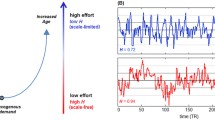Abstract
One of the major challenges of functional magnetic resonance imaging (fMRI) data analysis is to develop simple and reliable methods to correlate brain regions with functionality. In this paper, we employ a detrending-based fractal method, called detrended fluctuation analysis (DFA), to identify brain activity from fMRI data. We perform three tasks: (a) Estimating noise level from experimental fMRI data; (b) Assessing a signal model recently introduced by Birn et al.; and (c) Evaluating the effectiveness of DFA for discriminating brain activations from artifacts. By computing the receiver operating characteristic (ROC) curves, we find that the ROC curve for experimental data is similar to the curve for simulated data with similar signal-to-noise ratio (SNR). This suggests that the proposed algorithm for estimating noise level is very effective and that Birn’s model fits our experimental data very well. The brain activation maps for experimental data derived by DFA are similar to maps derived by deconvolution using a widely used software, AFNI. Considering that deconvolution explicitly uses the information about the experimental paradigm to extract the activation patterns whereas DFA does not, it remains to be seen whether one can effectively integrate the two methods to improve accuracy for detecting brain areas related to functional activity.









Similar content being viewed by others
References
Birn RM, Bandettini PA, Cox RW, Shaker R (1999) Event-related fMRI of tasks involving brief motion. Hum Brain Mapp 7:106–114
Birn RM, Cox RW, Bandettini PA (2004) Experimental designs and processing strategies for fMRI studies involving overt verbal responses. NeuroImage 23:1046–1058
Bullmore E, Long C, Suckling J, Fadili J, Calvert G, Zelaya F, Carpenter TA, Brammer M (2001) Colored noise and computational inference in neurophysiological (fMRI) time series analysis: Resampling methods in time and wavelet domain. Hum Brain Mapp 12:61–78
Cohen MS (1997) Parametric analysis of fMRI data using linear systems methods. NeuroImage 6:93–103
Cox RW (1996) AFNI: Software for analysis and visualization of functional magnetic resonance neuroimages. Comput Biomed Res 29:162–173
Desco M, Hernandez JA, Santos A, Brammer M (2001) Multiresolution analysis in fMRI: sensitivity and specificity in the detection of brain activation. Hum Brain Mapp 14:16–27
Friman O, Cedefamn J, Lundberg P, Borga H, Knutsson H (2001) Detection of neural activity in functional MRI using canonical correlation analysis. Magn Reson Med 45:323–330
Gao JB, Hu J, Tung WW, Cao YH, Sarshar N, Roychowdhury VP (2006) Assessment of long range correlation in time series: How to avoid pitfalls. Phys Rev E 73:016117
Glover GH (1999) Deconvolution of impulse response in event-related BOLD fMRI. NeuroImage 9:416–429
Hu K, Ivanov PC, Chen Z, Carpena P, Stanley HE (2001) Effect of trends on detrended fluctuation analysis. Phys Rev E 64:011114
Hu J, Gao JB, Posner FL, Zheng Y, Tung WW (2006) Target detection within sea clutter: a comparative study by fractal scaling analyses. Fractal 14:187–204
Lee JM, Hu J, Gao JB, Crosson B, Peck KK, Wierenga CE, McGregor K, Zhao Q, White KD (2008) Discriminating brain activity from task-related artifacts in functional MRI: fractal scaling analysis, simulation and application. NeuroImage (in press). http://dx.doi.org/10.1016/j.neuroimage.2007.11.016
Mandelbrot BB (1982) The fractal geometry of nature. Freeman, San Francisco
Masayuki K, Sung YW, Ogawa S (2004) A dynamic system model-based technique for functional MRI data analysis. NeuroImage 22:179–187
McKeown MJ, Makeig S, Brown GG, Jung TP, Kindermann SS, Bell AJ, Sejnowski TJ (1998) Analysis of fMRI data by blind separation into independent spatial components. Hum Brain Mapp 6:160–188
Muller K, Lohmann G, Bosch V, vonCramon DY (2001) On multivariate spectral analysis of fMRI time series. NeuroImage 14:347–356
Peng CK, Buldyrev SV, Havlin S, Simons M, Stanley HE, Goldberger AL (1994) Mosaic organization of DNA nucleotides. Phys Rev E 49:1685–1689
Shimizu Y, Barth M, Windischberger C, Moser E, Thurner S (2004) Wavelet-based multifractal analysis of fMRI time series. NeuroImage 22:1195–1202
Skudlarski P, Constable RT, Gore JC (1999) ROC analysis of statisticalmethods used in functional MRI: individual subjects. Neuroimage 9:311–329
Sun FT, Miller LM, D’Esposito M (2004) Measuring interregional functional connectivity using coherence and partial coherence analyses of fMRI data. NeuroImage 21:647–658
Thurner S, Windischberger C, Moser E, Walla P, Barth M (2003) Scaling laws and persistence in human brain activity. Physica A 326:511–521
Worsley KJ, Friston KJ (1995) Analysis of fMRI time-series revisited again. NeuroImage 2:173–181
Yousry TA, Schmid UD, Alkadhi H, Schmidt D, Peraud A, Buettner A, Winkler P (1997) Localization of the motor hand area to a knob on the precentral gyrus––a new landmark. Brain 120:141–157
Zarahn E, Aguirre GK, D’Esposito M (1997) Empirical analyses of BOLD fMRI statistics. Part 1. Spatially unsmoothed data collected under null-hypothesis conditions. NeuroImage 5:179–197
Zhao Q, Duensing G, Fitzsimmons J (2003) Development of smart phantom for charactering fMRI informatics tools. Proc Intl Soc Mag Reson Med 11:1834
Acknowledgments
This work was supported by Brain Rehabilitation Research Center VA Center of Excellence grant VARR&D F2182C, Research Career Scientist Award VARR&D B3470S to BC, NIH grant P50-DC03888 (BC, core PI), and the Evelyn F. McKnight Brain Research Grant Program at the University of Florida (JBG, KDW).
Author information
Authors and Affiliations
Corresponding author
Rights and permissions
About this article
Cite this article
Hu, J., Lee, JM., Gao, J. et al. Assessing a signal model and identifying brain activity from fMRI data by a detrending-based fractal analysis. Brain Struct Funct 212, 417–426 (2008). https://doi.org/10.1007/s00429-007-0166-9
Received:
Accepted:
Published:
Issue Date:
DOI: https://doi.org/10.1007/s00429-007-0166-9




